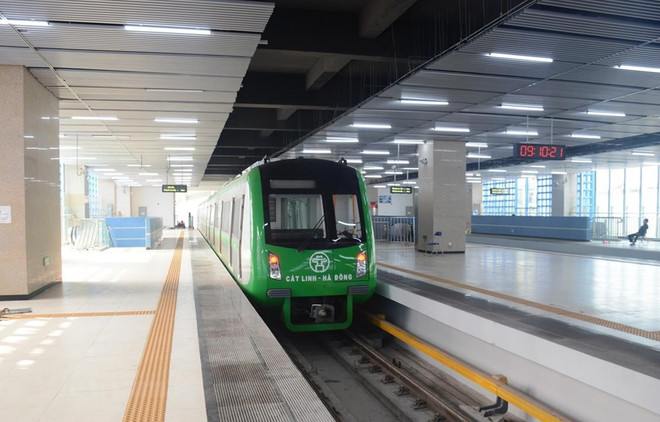 Cat Linh-Ha Dong urban railway project has yet to be put into commercial operation (Photo: Vietnam +)
Cat Linh-Ha Dong urban railway project has yet to be put into commercial operation (Photo: Vietnam +)Hanoi (VNA) - After the urban railway No. 2A (Cat Linh-Ha Dong) is put into operation, the Department of Transport forecasts that about 15-20% of people will switch from private vehicles to urban railway No. 2A, which is mainly populated by people living along the line.
Three scenarios of bus network’s adjustment
The Hanoi’s Department of Transport has just reported to the municipal People's Committee a plan to connect and transit passengers between the public passenger transport system by bus and the urban railway No. 2A (Cat Linh- Ha Dong) in which the Department offers 3 scenarios to adjust the bus network connected to this urban railway.
Specifically, the first scenario (the first 15 days free of charge): to operate bus routes according to the current operation plan, the operating targets remain the same as at present to ensure the travel of passengers not be disturbed during the free trial basis of the urban railway system during the beginning of commercial operation.
Scenario 2: after the time of using free-of-charge, four bus routes (02, 21, 27, 33) will be adjusted coinciding with the route of the Cat Linh-Ha urban railway; adjusting the bus routes to increase connectivity at the terminals; maintaining the operation of 20 cross-linked bus routes, the routes of which coincide with that of the 2A urban railway.
Notably, the Hanoi Department of Transport also presented the third scenario in case the train stops working for more than 2 hours in the first 3 months after being put into commercial operation. Under this scenario, Hanoi will operate buses according to the adjusted plan in the first 3 months after the train goes into commercial operation in scenario 2; at the same time, using more vehicles to relieve passengers at the stations.
Number of buses, taxis, grab cars expected to decrease
With the adjustment of the connecting network, leaders the Department of Transport assessed that the capacity of the public passenger transport system will increase, in which the main operation of axis the route (from Yen Nghia Station – So crossroad) will increase by 3-4 times compared to the present rate, meeting about 50% of the total travel needs of people on the route.
In particular, the transit capacity of the bus system with the 2A urban railway ensures the optimal supply and clearance for the 2A urban railway with the transfer capacity of 313,000-344,000 passengers / day (at the terminals of about 140,000 passengers/day; horizontal connections of about 203,000 guests / day).
“The buses are adjusted to reduce the number of operating vehicles, passengers currently using buses will opt for urban railways 2A. Especially with Nguyen Trai and Quang Trung-Tran Phu (Ha Dong) roads, bus traffic will be reduced by 30-45%,”said a leader of the Department of Transport.
In addition, leader of the Department of Transport also emphasized the level of people's access to public passenger transport will be more convenient when limiting the time of delay due to improved operating speed , the risk of congestion will also decrease.
 Bus routes are rearranged to strengthen connection with 12 stations of the Cat Linh- Ha Dong urban railway line (Photo:VNA)
Bus routes are rearranged to strengthen connection with 12 stations of the Cat Linh- Ha Dong urban railway line (Photo:VNA)At the beginning, the Hanoi Department of Transport forecasted that about 15-20% of people will switch from private vehicles to using Cat Linh-Ha Dong urban railway, who are mainly living along the line.
Particularly, the traffic of taxis, Grabs, etc. operating along the 2A urban railway route will also decrease because people will tend to use the bus to the 2A urban railway stations to transit to urban railway thanks to low transportation costs, reduced travel time and unaffected by traffic congestion./.
Work on Hanoi’s first metro line, the Cat Linh - Ha Dong urban railway line, commenced in October 2011 and was originally scheduled for completion in 2013. But several hurdles, including loan disbursement issues with China that were only resolved in December 2017, stalled it for years. The Cat Linh - Ha Dong line has almost been complete but has not been put into operation because it has yet been certified as safe for official operation, Minister of Transport Nguyen Van The said in a report sent to the NA session. The first urban railway line, which is 99% complete, was originally estimated to cost 552.86 million USD, partially funded by China’s official development assistance (ODA). In early 2014, the project’s investment was raised to 868 million USD, forcing Vietnam to take an additional ODA loan of 250.62 million USD from China. |
























